- 联系我们
- duidaima.com 版权声明
- 闽ICP备2020021581号
-
 闽公网安备 35020302035485号
闽公网安备 35020302035485号
 闽公网安备 35020302035485号
闽公网安备 35020302035485号
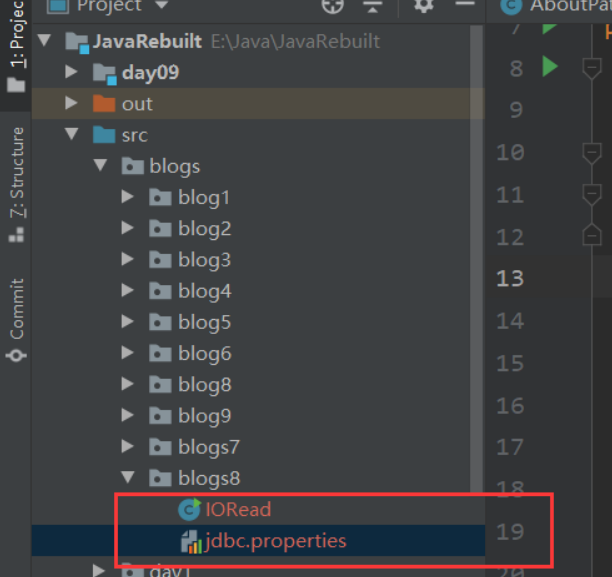

package blogs.blogs8;
import java.io.FileInputStream;
import java.io.IOException;
import java.util.Properties;
public class IORead {
public static void main(String[] args) {
FileInputStream f = null;
try {
// 堆代码 duidaima.com
// 创建字节输入流对象
// 在IDEA 中的默认相对路径是在 src 同级目录下的
f = new FileInputStream("src/blogs/blogs8/jdbc.properties");
// 创建Map集合中的 Properties 对象
Properties properties = new Properties();
properties.load(f);
// 通过 key 读取对应的键值对
String user = properties.getProperty("user");
System.out.println(user);
String password = properties.getProperty("password");
System.out.println(password);
} catch (IOException e) {
e.printStackTrace();
} finally {
// 关闭IO资源
if(f == null) {
try {
f.close();
} catch (IOException e) {
e.printStackTrace();
}
}
}
}
}

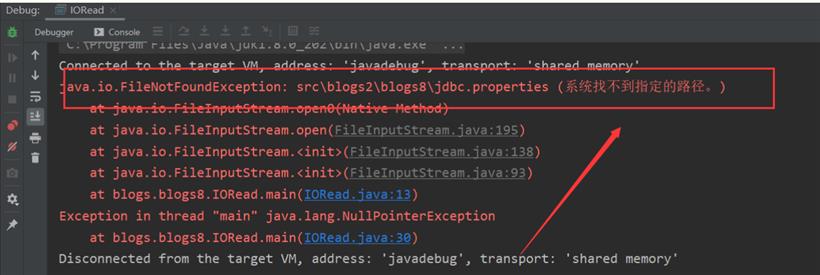
String path = Thread.currentThread().getContextClassLoader().getResource("db.properties").getPath();
/*
解释:
Thread.currentThread() 当前线程对象
getContextClassLoader() 是线程对象的方法,可以获取到当前线程的类加载对象
getResource() 获取资源:这是类加载器对象的方法,当前线程的类加载器默认从类的根路径下加载资源。
getPath() 获取当文件的绝对路径
*/
1.1 情况一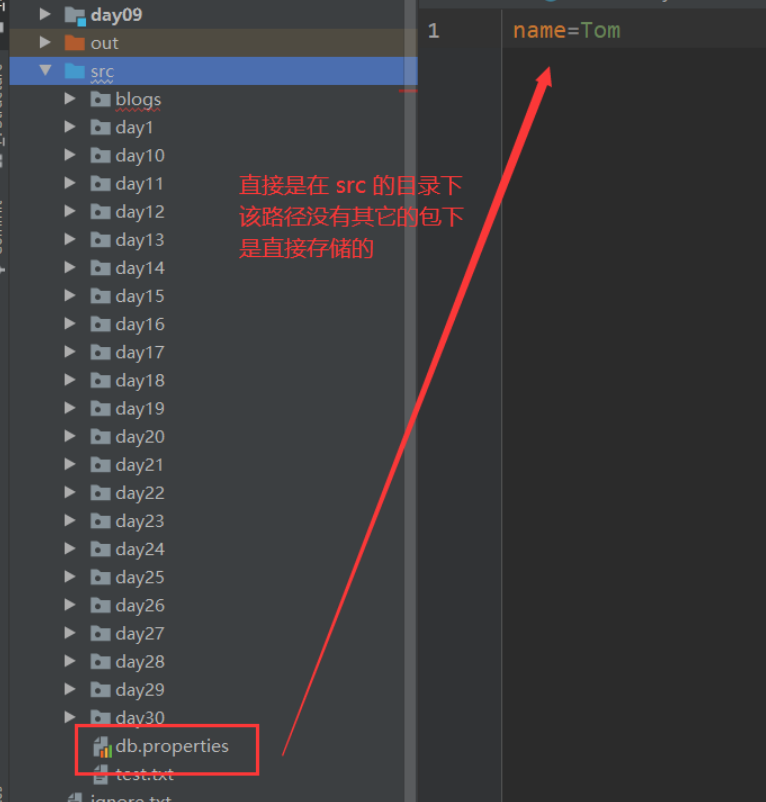
import java.io.FileInputStream;
import java.io.IOException;
import java.util.Properties;
public class IORead {
public static void main(String[] args) {
String path = Thread.currentThread().getContextClassLoader().getResource("db.properties").getPath();
System.out.println(path); // 返回该文件的绝对路径:
}
}

import java.io.FileInputStream;
import java.io.IOException;
import java.util.Properties;
// 堆代码 duidaima.com
public class IORead {
public static void main(String[] args) {
FileInputStream f = null;
try {
// 获取到该配置文件的的绝对路径
String path = Thread.currentThread().getContextClassLoader().getResource("db.properties").getPath();
// 通过该获取的文件的绝对路径创建 字节输入流对象
f = new FileInputStream(path);
// 创建Map集合中的 Properties 对象
Properties properties = new Properties();
properties.load(f);
// 通过 key 读取对应的键值对
String user = properties.getProperty("user");
System.out.println(user);
String password = properties.getProperty("password");
System.out.println(password);
} catch (IOException e) {
e.printStackTrace();
} finally {
// 关闭IO资源
if (f != null) {
try {
f.close();
} catch (IOException e) {
e.printStackTrace();
}
}
}
}
}

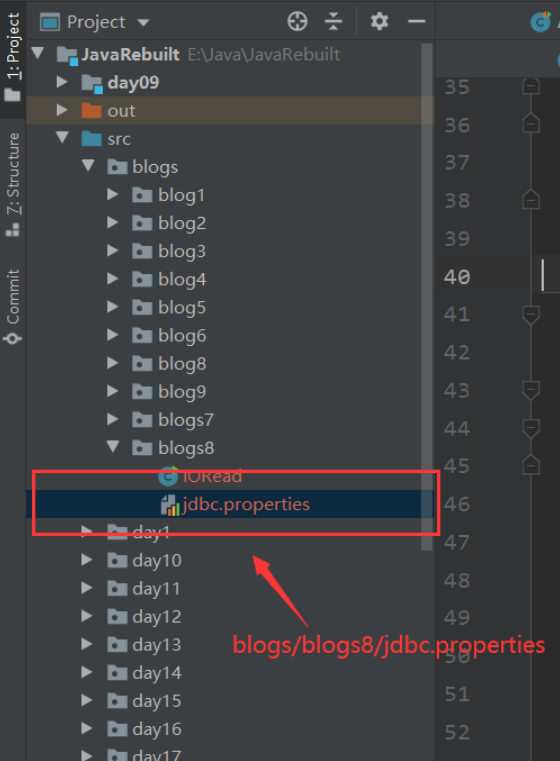
import java.io.FileInputStream;
import java.io.IOException;
import java.util.Properties;
public class IORead {
public static void main(String[] args) {
FileInputStream f = null;
try {
// 获取到该配置文件的的绝对路径,如下src目录下还有目录(包),需要指定 src目录下/包下的哪个文件。
String path = Thread.currentThread().getContextClassLoader().getResource("blogs/blogs8/jdbc.properties").getPath();
// 通过该获取的文件的绝对路径创建 字节输入流对象
f = new FileInputStream(path);
// 创建Map集合中的 Properties 对象
Properties properties = new Properties();
properties.load(f);
// 通过 key 读取对应的键值对
String user = properties.getProperty("user");
System.out.println(user);
String password = properties.getProperty("password");
System.out.println(password);
} catch (IOException e) {
e.printStackTrace();
} finally {
// 关闭IO资源
if (f != null) {
try {
f.close();
} catch (IOException e) {
e.printStackTrace();
}
}
}
}

// 直接以流的形式返回。
InputStream resourceAsStream = Thread.currentThread().getContextClassLoader().
getResourceAsStream("db.properties");
举例:import java.io.IOException;
import java.io.InputStream;
import java.util.Properties;
public class IORead {
// 堆代码 duidaima.com
public static void main(String[] args) {
// 直接在 src目录下没有包含任何子目录,可以直接写文件名+ 后缀,而如果有子目录,需要指明子目录下的文件名+后缀名
InputStream inputStream = Thread.currentThread().getContextClassLoader().getResourceAsStream("db.properties");
// 创建 Properties 集合对象,通过流获取指定配置文件中的键值对信息
Properties properties = new Properties();
try {
properties.load(inputStream);
} catch (IOException e) {
e.printStackTrace();
}
String user = properties.getProperty("user");
System.out.println(user);
String password = properties.getProperty("password");
System.out.println(password);
// 关闭IO资源
if (inputStream != null) {
try {
inputStream.close();
} catch (IOException e) {
e.printStackTrace();
}
}
}
}
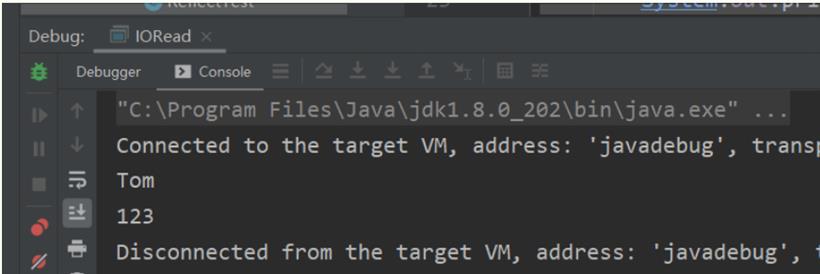
import java.util.ResourceBundle;
public class IORead {
public static void main(String[] args) {
ResourceBundle resourceBundle = ResourceBundle.getBundle("db");
String user = resourceBundle.getString("user");
System.out.println(user);
String password = resourceBundle.getString("password");
System.out.println(password);
}
}
4. 总结: